To distinguish influenza from SARS, it is necessary, first of all, to clarify the specifics of symptoms in adults and children. These pathologies are very often confused. This is due to the fact that influenza is one of the respiratory diseases of the viral type, and ARVI is a common the category of many viral agents of the respiratory type, that is, diseases in which the upper paths.
The flu also belongs to these diseases. That is, in fact, influenza is a subcategory of ARVI, which also includes adenovirus and rhinovirus infections, as well as respiratory syncytial virus. All these diseases are classified as acute respiratory diseases.
However, when making a diagnosis, doctors often use the concept of SARS or influenza. This suggests that the patient has no signs of only one viral disease (flu) and in addition, signs of other probable pathologies are traced.
Therefore, the doctor indicates the diagnosis of ARVI, since with the simultaneous course of several viral diseases, a completely different symptomatology is observed and different therapeutic measures are selected.
Record content:
-
1 Flu
- 1.1 Types, stages and degrees
- 1.2 Symptoms
- 1.3 Reasons for the appearance
- 1.4 Possible complications
- 1.5 The main methods of treatment
-
2 ARVI
- 2.1 Types, stages and degrees
- 2.2 Symptoms
- 2.3 Reasons for the appearance
- 2.4 Possible complications
- 2.5 The main methods of treatment
- 3 Similarities and differences
- 4 Flu and SARS Videos
Flu
It is not very easy to distinguish influenza from SARS in adults and children. However, if you know the types of each disease and the peculiarities of its course, it will be possible to determine some of the characteristic signs for yourself.
Influenza belongs to the category of seasonal viral diseases, from which about 90% of the population suffers to one degree or another. With a typical manifestation of the disease without serious complications, it is possible to overcome it rather quickly. But the problem is that there are several different types and strains of influenza.
Having been ill with one type of disease, a person remains protected from it for some time, thanks to the developed antibodies that the immune system synthesized. But this does not protect the body from the likelihood of contracting another strain of this virus.
Types, stages and degrees
There are many different subtypes of influenza. Some of them are very rare or are carried by a person in such a mild form that he does not even notice it. There are also more common varieties.
For example, there is influenza type A (there are also subtypes A1 and A2) and B. They do not appear so often, but if a hotbed of such flu occurs, then the situation can reach the level of a pandemic, in which 1/5 of the world's population suffers from the disease.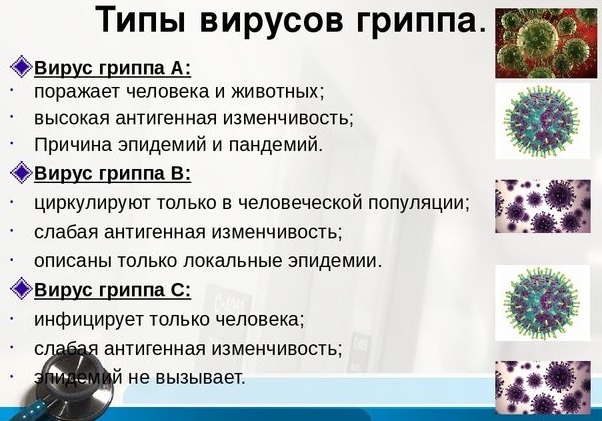
Such varieties are manifested in the form of weakness, a broken state, cough, fever with a high temperature. There is also type C flu. It is also extremely rare, but manifests itself and spreads as types A and B.
Avian influenza was discovered by doctors back in 1878. Then it was possible to find out that birds are able to carry influenza type A and its subtypes. But the birds of the category B and C are not able to tolerate. Later, bird flu was transferred to an independent group, as several of its varieties and mutations appeared. Today there are categories H5, H7, H9.
The first two types of avian influenza are considered the most dangerous, since a very high mortality rate among the population was recorded from such a disease.
The H9 subtype is not so dangerous, as it is extremely rarely fatal. However, the last most dangerous strain was H5N1.
It is a type of bird flu that has affected people very badly. Infection is possible only from wild birds. It is not possible to get infected from another person who has bird flu. But the problem is that poultry can also carry the virus. The main way to solve this problem is to thoroughly heat the poultry meat.
If we talk about the symptoms of bird flu, then it manifests itself in the form of:
- severe cough;
- fever with increased body temperature;
- soreness of muscles and joints.
In an advanced stage, avian flu can lead to breathing problems, and patients are diagnosed with pneumonia. Pneumonia is a very dangerous complication, since every second patient who has been diagnosed with such a diagnosis dies from it.
Also in group A is swine flu, which has been reported as H1N1. Pigs and humans can be affected by this disease, and they are also carriers of the virus.
The main feature of swine flu is that it appears only after a few days of infection. However, during this time, the virus actively spreads in the human body. In a few days, he can infect hundreds of people around him.
A difficult condition in a patient with H1N1 is observed during the first week after the first signs of swine flu. Even if the disease is successfully cured, there is a risk that the patient will remain its carrier for another 2 weeks and may infect others. The virus is transmitted by airborne droplets or by eating poorly cooked pork meat that is contaminated.
The swine flu does not appear during the first days, however, a person's breathing may deteriorate sharply. The process proceeds very quickly and if measures are not taken in a timely manner, then the patient develops pneumonia.
If we talk about the characteristic signs of this type of influenza A, then it is worth highlighting:
- temperature over 38 degrees;
- the patient's condition, which is rapidly deteriorating;
- severe headaches that do not go away for several days;
- a feeling of aches in the muscles and joints;
- lethargy, constant feeling of weakness, drowsiness.
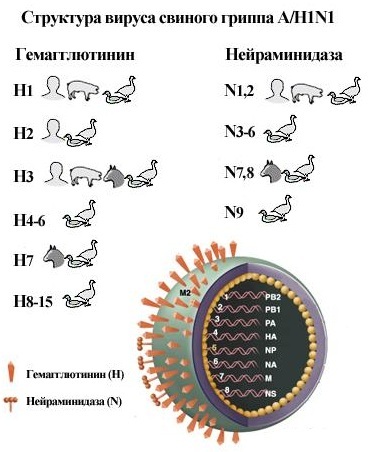
Swine flu also comes in several forms:
- Not complicated. In this case, the patient's temperature may rise to 39 degrees, he will complain of drowsiness, lethargy, pain in the throat. Sometimes a mild form of lack of air appears. Every second patient complains of diarrhea.
- Heavy. In addition to signs of a mild form of the disease, severe pain also appears in the forehead, as well as in the brow ridges. When the eyes move, soreness appears in the eyeballs with each movement. Some patients show signs of photophobia. With a severe form of the disease, severe respiratory failure is also observed, so the inhalation and exhalation is significantly accelerated, it becomes intermittent.
If we take a closer look at group B influenza. It was first registered in 1933 and classified as a virus. Later they began to compare it with influenza A, but subtype B did not have such a strong effect on people, since when it spread, it was impossible to talk about a pandemic. Another difference between influenza B and A is that only people suffer from it, that is, animals are not susceptible to this virus.
Symptoms
You can try to distinguish influenza from SARS in adults and children for signs of illness. However, even within a group of a particular disease, it is very difficult to determine the exact type of pathology.
As a rule, with swine and bird flu, the lungs are affected, that is, there are problems with breathing. However, even with common colds, a person often complains of coughing, nasal congestion, and breathing problems.
Nevertheless, there are some peculiarities and subtypes of influenza. For example, patients suffering from group B influenza not only have a high body temperature, but also a prolonged cough, which only gets worse every day.
The temperature with influenza B usually rises strongly and is at least 39 degrees. In this case, a feverish state can last up to 4 days. After that, symptoms are added in the form of a runny nose, nasal congestion, sore throat.

Most often, people bleat with the flu in late autumn, winter and early spring. At this time, a person's immunity is significantly reduced, since he consumes less fresh fruits and vegetables, and is not under the sun's rays. Therefore, it is during this period that various viral diseases are activated.
Very often, with a disease, soreness in the ears appears. In a child, the flu can provoke bouts of vomiting, diarrhea. Patients often complain of a lack of appetite.
Reasons for the appearance
As a rule, influenza infection occurs by airborne droplets, and SARS appears against a background of certain factors, for example, when the body is hypothermic.
That is, the flu spreads through contact with infected people or animals. For example, you can get swine flu if you eat meat that has not been properly cooked. However, even upon contact with an infected pig, a similar disease is often recorded.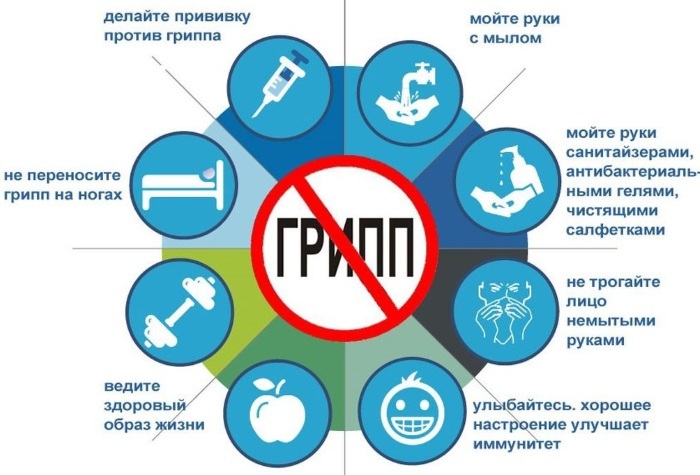
If we are talking about bird flu, then it is possible to become infected by contact with an infected animal or by eating its meat or by contacting a person with such a diagnosis.
Any type of flu is caused by a virus that constantly mutates. Against the background of it, more and more new strains of the disease appear. The source of infection is the person or animals themselves.
Possible complications
Previously, the flu itself posed a great threat, since in the early 20's people did not have the same technology as they do now. Today, medicine is much more developed and only a complication after the flu is dangerous, for example, if during the illness the patient did not comply with bed rest or treatment and did not at all was carried out.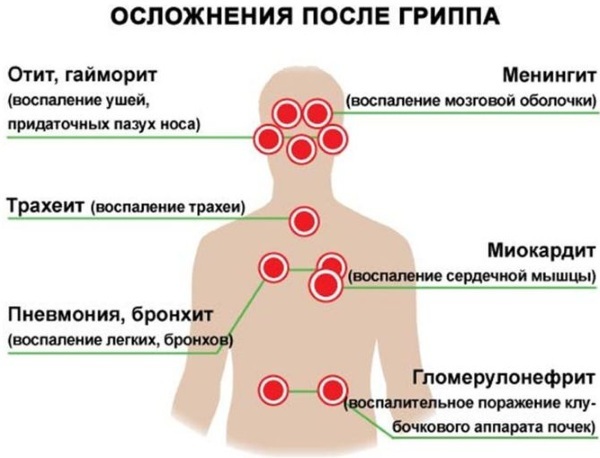
The most common complication after suffering from influenza A or B is myocarditis. This condition is most dangerous for those patients who suffer from pathologies of the cardiovascular system.
The virus can change the structure of the blood, which sometimes increases the number of platelets, and this leads to more intense blood clotting. This condition becomes an ideal condition for the formation of blood clots. Blue flu is dangerous because, as a complication, sometimes patients are diagnosed with kidney problems. This can provoke nephritis.
Influenza B often causes a number of complications at once. For example, a patient may develop bronchitis, respiratory tract damage, pneumonia.
The main methods of treatment
Since we are talking about a viral disease, the doctor usually prescribes drugs of the antiviral group. For example, at the first symptoms of flu, Arbidol is considered effective. This drug helps prevent the active growth of bacteria.
With this remedy, you are more likely to fight type A flu. In 80% of cases, it is Arbidol that can significantly alleviate the patient's condition and prevent the development of complications. It is 60% and 20% effective against influenza B and C, respectively.
The dosage of the drug is determined by the doctor depending on many factors. For example, children from 3 to 6 years old can be given no more than 50 mg of the drug per day.

Also, an important stage of treatment is to improve the functioning of the immune system. This task is best done by immunomodulatory drugs. The best remedy in this category is Amiksin. However, it should not be given to children under 7 years of age.
So-called symptomatic treatment is often prescribed. For example, for high fever, the doctor may prescribe Paracetamol, Aspirin. For vasoconstriction, Naphthyzin will help.
ARVI
Distinguishing flu from SARS is quite difficult. In adults and children, pathologies manifest themselves in a similar way. ARVI stands for acute respiratory viral infection, the category of which includes the flu itself, as well as parainfluenza, adenoviruses, rhinoviruses and much more. People encounter such viruses everywhere. But most often ARVI is diagnosed in children.
Types, stages and degrees
There are several of the most common diseases in the ARVI category. For example, parainfluenza is most often diagnosed. This is a viral infection that is anthroponotic in nature. Simply put, only people suffer from the disease. Parainfluenza negatively affects the state of the respiratory system.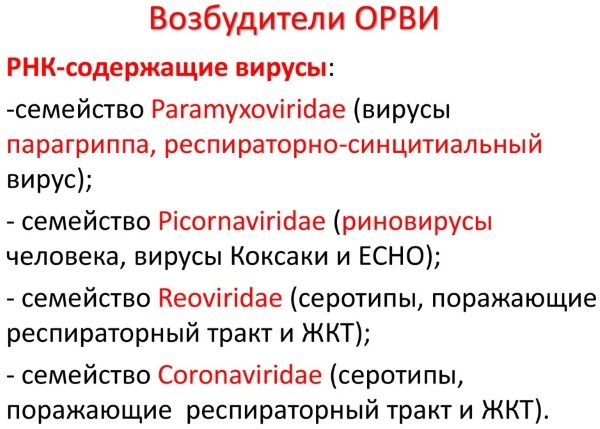
There are 5 types of parainfluenza, but only 3 subtypes can cause serious harm to health. This type of virus is transmitted by airborne droplets, through the mucous membranes (larynx, eyes, nasopharynx).
You can also get infected if the virus enters the blood of a person. The disease lasts for about a week. During this time, patients develop a headache, runny nose, weakness, cough, and other symptoms that are very similar to the flu.
Rhinovirus belongs to the category of RNA viruses. This means that the upper respiratory tract is primarily affected. The active multiplication of the virus occurs in the human nasopharynx.
If an adult suffers from rhinovirus, then he will not necessarily have an increased body temperature, and a febrile condition is almost always diagnosed in children. In this case, the disease can last from 5 to 9 days.
Respiratory syncytial virus also affects the respiratory system. Most often, children suffer from it, but children can also get infected. Patients experience weakness, loss of appetite, sometimes the temperature of the case rises. Most often, infection occurs through contact with an infected person.
The duration of the disease can be up to 8 days. With a mild degree, relief comes on the third day.
Adenoviruses also affect the performance of the human respiratory system. Most often, the disease is transmitted by airborne droplets. You can also get infected through contact with an infected person or his belongings.
Symptoms
It is quite difficult to distinguish influenza from SARS in adults and children, since, in general, diseases manifest themselves in approximately the same way. For example, with almost any type of ARVI, headaches, weakness, aches in muscles and joints appear.
Often, there may be pain in the eyeballs, especially when turning the head or rolling the eyes. Also, with ARVI, a rather severe runny nose, photosensitivity may appear. Many patients complain of irritation in the nasopharynx, which leads to sneezing and frequent coughing.
Reasons for the appearance
Children get sick with ARVI more often, so they often find themselves in conditions favorable for the spread of the virus. They often touch dirty things, walk on the street without hats and jackets. Hypothermia is one of the most common causes of ARVI development. Since infection is possible through contact with things that an infected person has touched, children are again at risk.
Also, children often rub their faces with dirty hands. A huge number of various viruses can enter the body through the mucous membranes. Considering that they are susceptible to mutation, it is not surprising that a person can get sick with different types of ARVI several times in a year.
Possible complications
After suffering parainfluenza, patients are sometimes diagnosed with the so-called asthenic syndrome. This means that the person is constantly experiencing a sense of weakness.
Parainfluenza is very similar to the flu, so the complications of these diseases are very similar. Parainfluenza affects the larynx, so laryngitis or laryngotracheitis can become a complication. Children are less tolerant of the disease, so they may also develop croup.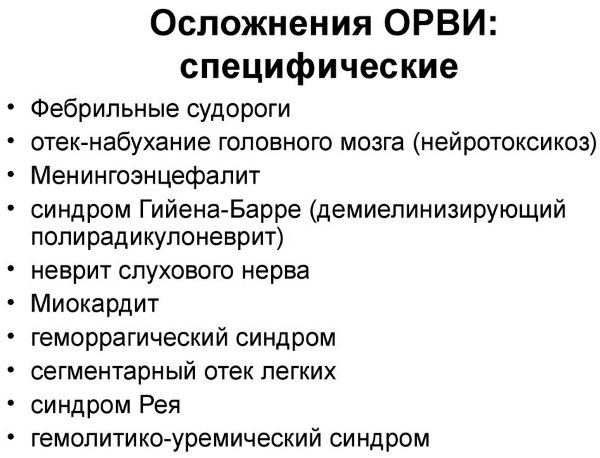
Complications rarely occur with rhinovirus. However, if treatment is not carried out at all or is performed too late, then this can provoke the development of sinusitis, bronchitis or otitis media.
The main methods of treatment
Treatment depends on the exact strain of the virus, which can only be determined in vitro. As a rule, doctors also prescribe treatment that is aimed at relieving the main symptoms: fever, cough, runny nose. Also, the doctor may prescribe drugs that stimulate the immune system.
An interesting method of treating such viral diseases has become the use of oxygen. It is a supportive therapy that makes it easier for the patient to breathe. It is also allowed to use traditional medicine methods of treatment.
For example, herbal preparations, warming and other methods can speed up the healing process. However, at elevated body temperature, thermal procedures are not allowed. As with the flu, traditional medicine is allowed only with the permission of a doctor and only as an additional therapy.
Similarities and differences
It is possible to distinguish influenza from acute respiratory viral infections in adults if the features of the diseases are correlated. It is most convenient to perform the comparison in the form of a table.

| Features of symptoms | With the flu | With ARVI |
| Onset of the disease | The body temperature can rise sharply, as the body is actively attacked by the virus. | The first manifestations may appear only after a few days, since the disease develops more slowly than the flu. |
| Body temperature | For several days, the indicators can stay at the level of 39-40 C. | The temperature rarely exceeds 38-38.5 C. A decrease in indicators is also observed after a few days. |
| Additional symptoms | Aches in muscles, joints. Discomfort appears even during rest, when a person is in a horizontal position. There is a throbbing pain in the temples, chills, increased sweating, photophobia appear. | A decrease in performance is observed. The pain syndrome is not as strong as with the flu, it may not appear at all. |
| Nose | The nose does not block up only if the person does not have chronic pathologies, sinusitis or sinusitis. | The nose is stuffy, a severe runny nose may also appear, a person sneezes profusely. The patient may also have a light yellow nasal discharge. |
| Throat | Inflamed, severe redness. The sky is swollen. | The throat is red and has a loose structure. |
| Nasopharyngeal mucosa | There is no plaque. | There is a raid. |
| The lymph nodes | Do not get inflamed. | More often inflamed. |
| Eyes | There is redness, photosensitivity, there is a risk of developing viral conjunctivitis. | There is redness, the eyes look sore. |
| Duration of illness | With proper treatment, patients experience relief after 10 days, body temperature drops by 3-5 days. | Lasts no more than 1 week. |
Both types of the disease have a rather short incubation period. The only difference is that with the flu, the first signs are brighter. Usually, the peak of the disease is reached on day 3-4, after which the unpleasant symptoms gradually decrease.
Treatment is based on the underlying symptoms, as eliminating them helps the person feel much better. After getting rid of pain and breathing problems, therapy is usually started to improve the state of the immune system.
The flu virus and SARS remain infectious for about a week after the patient is cured. Even if a person feels well, he can be a source of infection, so it is advisable to keep contact to a minimum and spend some time at home.
To distinguish influenza from SARS, do not self-diagnose. In adults and children, these pathologies can manifest themselves in different forms. The main danger of viral diseases lies in possible complications.
Although diseases are treated according to very similar schemes, it is better to clarify the exact diagnosis, which can only be made by a doctor. Therefore, it is worth contacting a therapist at the nearest clinic.
Flu and SARS Videos
How to distinguish influenza from SARS:



